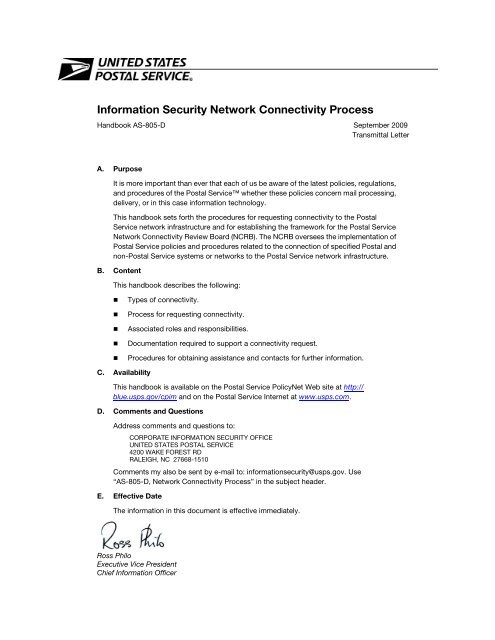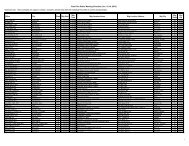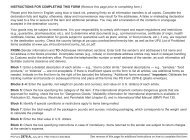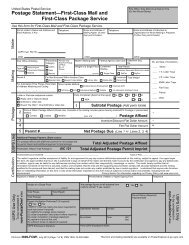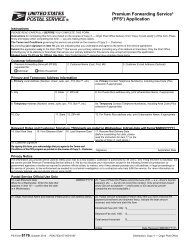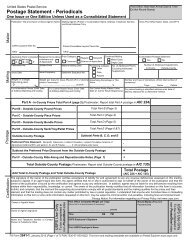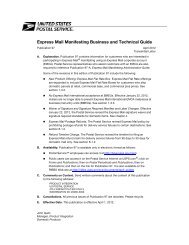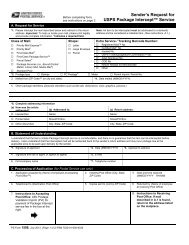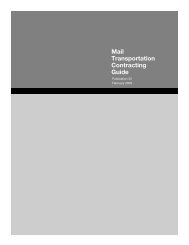Information Security Network Connectivity Process - USPS.com
Information Security Network Connectivity Process - USPS.com
Information Security Network Connectivity Process - USPS.com
Create successful ePaper yourself
Turn your PDF publications into a flip-book with our unique Google optimized e-Paper software.
<strong>Information</strong> <strong>Security</strong> <strong>Network</strong> <strong>Connectivity</strong> <strong>Process</strong><br />
Handbook AS-805-D September 2009<br />
Transmittal Letter<br />
A. Purpose<br />
It is more important than ever that each of us be aware of the latest policies, regulations,<br />
and procedures of the Postal Service whether these policies concern mail processing,<br />
delivery, or in this case information technology.<br />
This handbook sets forth the procedures for requesting connectivity to the Postal<br />
Service network infrastructure and for establishing the framework for the Postal Service<br />
<strong>Network</strong> <strong>Connectivity</strong> Review Board (NCRB). The NCRB oversees the implementation of<br />
Postal Service policies and procedures related to the connection of specified Postal and<br />
non-Postal Service systems or networks to the Postal Service network infrastructure.<br />
B. Content<br />
This handbook describes the following:<br />
Types of connectivity.<br />
<strong>Process</strong> for requesting connectivity.<br />
Associated roles and responsibilities.<br />
Documentation required to support a connectivity request.<br />
Procedures for obtaining assistance and contacts for further information.<br />
C. Availability<br />
This handbook is available on the Postal Service PolicyNet Web site at http://<br />
blue.usps.gov/cpim and on the Postal Service Internet at www.usps.<strong>com</strong>.<br />
D. Comments and Questions<br />
Address <strong>com</strong>ments and questions to:<br />
CORPORATE INFORMATION SECURITY OFFICE<br />
UNITED STATES POSTAL SERVICE<br />
4200 WAKE FOREST RD<br />
RALEIGH, NC 27668-1510<br />
Comments my also be sent by e-mail to: informationsecurity@usps.gov. Use<br />
“AS-805-D, <strong>Network</strong> <strong>Connectivity</strong> <strong>Process</strong>” in the subject header.<br />
E. Effective Date<br />
The information in this document is effective immediately.<br />
Ross Philo<br />
Executive Vice President<br />
Chief <strong>Information</strong> Officer
Contents<br />
1 Introduction. . . . . . . . . . . . . . . . . . . . . . . . . . . . . . . . . . . . . . . . . . . . . . . . . . . . . 1<br />
1-1 Policy . . . . . . . . . . . . . . . . . . . . . . . . . . . . . . . . . . . . . . . . . . . . . . . . . . . . . . . . . . . . . . . . . . . 1<br />
1-2 Contents of This Handbook . . . . . . . . . . . . . . . . . . . . . . . . . . . . . . . . . . . . . . . . . . . . . . . . . . 1<br />
1-3 Objectives of the <strong>Network</strong> <strong>Connectivity</strong> <strong>Process</strong> . . . . . . . . . . . . . . . . . . . . . . . . . . . . . . . . . . 1<br />
1-4 Postal Service Standard <strong>Network</strong>ed User Interface . . . . . . . . . . . . . . . . . . . . . . . . . . . . . . . . 2<br />
1-5 <strong>Network</strong> <strong>Connectivity</strong> Review Board . . . . . . . . . . . . . . . . . . . . . . . . . . . . . . . . . . . . . . . . . . . 2<br />
1-5.1 Purpose . . . . . . . . . . . . . . . . . . . . . . . . . . . . . . . . . . . . . . . . . . . . . . . . . . . . . . . . . . . . . . 2<br />
1-5.2 <strong>Network</strong> <strong>Connectivity</strong> Review Board <strong>Process</strong> Overview. . . . . . . . . . . . . . . . . . . . . . . . . 3<br />
1-5.3 NCRB Membership . . . . . . . . . . . . . . . . . . . . . . . . . . . . . . . . . . . . . . . . . . . . . . . . . . . . . 4<br />
1-6 NCRB <strong>Connectivity</strong> Tool Kit . . . . . . . . . . . . . . . . . . . . . . . . . . . . . . . . . . . . . . . . . . . . . . . . . . 4<br />
1-7 Granting an Exception to the Policies . . . . . . . . . . . . . . . . . . . . . . . . . . . . . . . . . . . . . . . . . . 4<br />
2 Roles and Responsibilities . . . . . . . . . . . . . . . . . . . . . . . . . . . . . . . . . . . . . . . . 5<br />
2-1 General . . . . . . . . . . . . . . . . . . . . . . . . . . . . . . . . . . . . . . . . . . . . . . . . . . . . . . . . . . . . . . . . . . 5<br />
2-2 Manager Corporate <strong>Information</strong> <strong>Security</strong> Office. . . . . . . . . . . . . . . . . . . . . . . . . . . . . . . . . . . 5<br />
2-3 Manager, Tele<strong>com</strong>munications Services . . . . . . . . . . . . . . . . . . . . . . . . . . . . . . . . . . . . . . . . 5<br />
2-4 NCRB Change Control Board. . . . . . . . . . . . . . . . . . . . . . . . . . . . . . . . . . . . . . . . . . . . . . . . . 6<br />
2-5 Chairperson, <strong>Network</strong> <strong>Connectivity</strong> Review Board . . . . . . . . . . . . . . . . . . . . . . . . . . . . . . . . 6<br />
2-6 <strong>Network</strong> <strong>Connectivity</strong> Review Board . . . . . . . . . . . . . . . . . . . . . . . . . . . . . . . . . . . . . . . . . . . 6<br />
2-7 Executive Sponsors . . . . . . . . . . . . . . . . . . . . . . . . . . . . . . . . . . . . . . . . . . . . . . . . . . . . . . . . 7<br />
2-8 Portfolio Managers . . . . . . . . . . . . . . . . . . . . . . . . . . . . . . . . . . . . . . . . . . . . . . . . . . . . . . . . . 8<br />
2-9 Business Partners. . . . . . . . . . . . . . . . . . . . . . . . . . . . . . . . . . . . . . . . . . . . . . . . . . . . . . . . . . 9<br />
2-10 Requesters of <strong>Connectivity</strong> to Externally Facing Applications . . . . . . . . . . . . . . . . . . . . . . . . 10<br />
2-11 <strong>Information</strong> Systems <strong>Security</strong> Officers . . . . . . . . . . . . . . . . . . . . . . . . . . . . . . . . . . . . . . . . . . 11<br />
3 <strong>Network</strong> <strong>Connectivity</strong> <strong>Process</strong> . . . . . . . . . . . . . . . . . . . . . . . . . . . . . . . . . . . . . 13<br />
3-1 Determination of Need for <strong>Connectivity</strong> Request . . . . . . . . . . . . . . . . . . . . . . . . . . . . . . . . . . 13<br />
3-1.1 Types of <strong>Connectivity</strong> Requiring Review by the NCRB . . . . . . . . . . . . . . . . . . . . . . . . . 13<br />
3-1.2 Documentation Requirements for the <strong>Connectivity</strong> Request Package. . . . . . . . . . . . . .<br />
3-1.3 Extending the Postal Service Internal <strong>Network</strong> Into A Remote Business<br />
14<br />
Partner Site . . . . . . . . . . . . . . . . . . . . . . . . . . . . . . . . . . . . . . . . . . . . . . . . . . . . . . . . . . . 14<br />
3-1.4 Business Partner Database <strong>Connectivity</strong> . . . . . . . . . . . . . . . . . . . . . . . . . . . . . . . . . . . . 15<br />
3-2 Request Initiation . . . . . . . . . . . . . . . . . . . . . . . . . . . . . . . . . . . . . . . . . . . . . . . . . . . . . . . . . . 15<br />
3-3 Preliminary Request Evaluation . . . . . . . . . . . . . . . . . . . . . . . . . . . . . . . . . . . . . . . . . . . . . . . 16<br />
3-4 <strong>Network</strong> <strong>Connectivity</strong> Review Board Engineer Evaluation . . . . . . . . . . . . . . . . . . . . . . . . . . .<br />
3-5 Evaluation of Nonstandard <strong>Connectivity</strong> Requests by <strong>Network</strong> <strong>Connectivity</strong><br />
16<br />
Review Board . . . . . . . . . . . . . . . . . . . . . . . . . . . . . . . . . . . . . . . . . . . . . . . . . . . . . . . . . . . . . 16<br />
September 2009 iii
3-6 Approval . . . . . . . . . . . . . . . . . . . . . . . . . . . . . . . . . . . . . . . . . . . . . . . . . . . . . . . . . . . . . . . . . 17<br />
3-7 Implementation . . . . . . . . . . . . . . . . . . . . . . . . . . . . . . . . . . . . . . . . . . . . . . . . . . . . . . . . . . . . 17<br />
3-8 Escalation Procedures . . . . . . . . . . . . . . . . . . . . . . . . . . . . . . . . . . . . . . . . . . . . . . . . . . . . . . 17<br />
3-9 Monitoring. . . . . . . . . . . . . . . . . . . . . . . . . . . . . . . . . . . . . . . . . . . . . . . . . . . . . . . . . . . . . . . . 17<br />
4 <strong>Connectivity</strong> Request Documentation Requirements . . . . . . . . . . . . . . . . . . 19<br />
4-1 General . . . . . . . . . . . . . . . . . . . . . . . . . . . . . . . . . . . . . . . . . . . . . . . . . . . . . . . . . . . . . . . . . . 19<br />
4-2 Business Case and <strong>Connectivity</strong> Description. . . . . . . . . . . . . . . . . . . . . . . . . . . . . . . . . . . . . 19<br />
4-3 Architectural Diagrams . . . . . . . . . . . . . . . . . . . . . . . . . . . . . . . . . . . . . . . . . . . . . . . . . . . . . . 19<br />
4-4 Facilities and Postal Inspection Service Approvals . . . . . . . . . . . . . . . . . . . . . . . . . . . . . . . . 20<br />
4-5 Configuration and Enforcement Strategy . . . . . . . . . . . . . . . . . . . . . . . . . . . . . . . . . . . . . . . . 20<br />
4-6 Site <strong>Security</strong> Review . . . . . . . . . . . . . . . . . . . . . . . . . . . . . . . . . . . . . . . . . . . . . . . . . . . . . . . . 21<br />
4-7 NCRB Request Forms . . . . . . . . . . . . . . . . . . . . . . . . . . . . . . . . . . . . . . . . . . . . . . . . . . . . . . 21<br />
5 Contact <strong>Information</strong> . . . . . . . . . . . . . . . . . . . . . . . . . . . . . . . . . . . . . . . . . . . . . . 23<br />
September 2009 iv
1 Introduction<br />
1-1 Policy<br />
The Postal Service is <strong>com</strong>mitted to creating and maintaining a cost-effective<br />
information security environment to safeguard the integrity, confidentiality,<br />
and availability of Postal Service information and to protect the interests of<br />
the Postal Service, its personnel, its business partners, and the general<br />
public. This <strong>com</strong>mitment includes protecting the network infrastructure at a<br />
level <strong>com</strong>mensurate to its value to the Postal Service.<br />
Such protection covers implementation of physical, administrative, and<br />
technical security controls and processes that will safeguard the network<br />
infrastructure in accordance with Postal Service policies and procedures.<br />
These controls establish standards and processes for governance of<br />
connectivity to the Postal Service network infrastructure.<br />
1-2 Contents of This Handbook<br />
This handbook describes the process for requesting connectivity to the<br />
Postal Service network infrastructure, the associated roles and<br />
responsibilities, and the role of the <strong>Network</strong> <strong>Connectivity</strong> Review Board<br />
(NCRB). Additional policies about the Postal Service network infrastructure<br />
are documented in Handbook AS-805, <strong>Information</strong> <strong>Security</strong>.<br />
1-3 Objectives of the <strong>Network</strong> <strong>Connectivity</strong> <strong>Process</strong><br />
The network connectivity process is intended to:<br />
a. Control access to Postal Service <strong>com</strong>puter systems and networks.<br />
b. Ensure <strong>com</strong>pliance with Postal Service information system security<br />
policies and procedures.<br />
c. Ensure <strong>com</strong>pliance with Postal Service information resource and<br />
<strong>com</strong>munications standards.<br />
d. Identify preparatory and support activities that non-Postal Service<br />
connections will require.<br />
e. Keep requirements for Postal Service applications and network<br />
infrastructure capabilities up to date.<br />
September 2009 1
1-4 <strong>Information</strong> <strong>Security</strong> <strong>Network</strong> <strong>Connectivity</strong> <strong>Process</strong><br />
f. Provide Postal Service customers with the network security<br />
requirements to ensure the contracts are <strong>com</strong>pliant with network<br />
infrastructure services.<br />
g. Ensure that remote Business Partner privileged usage in the<br />
de-militarized zone (DMZ) and in secure enclaves uses two-factor<br />
authentication.<br />
h. Ensure that unauthorized connectivity of information resources are<br />
brought into <strong>com</strong>pliance or removed.<br />
1-4 Postal Service Standard <strong>Network</strong>ed User Interface<br />
The standard networked user interface for the Postal Service is the<br />
Advanced Computing Environment (ACE)-approved hardware and software<br />
configurations. The NCRB must assess and approve all non-ACE networkenabled<br />
hardware and software prior to connecting to the Postal Service<br />
intranet. The exception is nonroutable mail processing equipment and mail<br />
processing infrastructure (MPE/MPI) devices that are only connected to MPE<br />
local area networks (LANs).<br />
1-5 <strong>Network</strong> <strong>Connectivity</strong> Review Board<br />
1-5.1 Purpose<br />
The NCRB oversees the implementation of policies and procedures relating<br />
to the connection of systems or networks to the Postal Service network<br />
infrastructure. The NCRB evaluates requests for connectivity to the Postal<br />
Service network for development, system integration testing, customer<br />
acceptance testing, production, and internal networks in cases where<br />
connectivity requests do not <strong>com</strong>ply with pre-established connectivity<br />
standards.<br />
The NCRB evaluates and either approves or denies any changes to Postal<br />
Service firewall configurations. No changes are made to firewall<br />
configurations by Tele<strong>com</strong>munications Services personnel or their designees<br />
without the evaluation of and the approval by either the NCRB chairperson or<br />
his/her designee or the NCRB (as applicable).<br />
Note: The manager, Corporate <strong>Information</strong> <strong>Security</strong> Office, is<br />
responsible for approving the configuration of all firewalls within the<br />
Postal Service infrastructure.<br />
2 Handbook AS-805-D
Introduction 1-5.2<br />
Exhibit 1-5.2<br />
NCRB <strong>Process</strong><br />
1-5.2 <strong>Network</strong> <strong>Connectivity</strong> Review Board <strong>Process</strong><br />
Overview<br />
An overview of the NCRB process is presented in Exhibit 1-5.2 followed by a<br />
brief description of the steps in the NCRB process.<br />
Step 1, Determination of Need for <strong>Connectivity</strong> Request and Submission<br />
of the Request — The requester and executive sponsor determine the need<br />
for connectivity to Postal Service network infrastructure. The requester and<br />
executive sponsor submit an online request with a Technical Architectural<br />
Drawing and the appropriate documentation (see 3-1.2, Documentation<br />
Requirements for the <strong>Connectivity</strong> Request Package). A reference number is<br />
assigned to the request upon submission of the request. Use the reference<br />
number in all <strong>com</strong>munication about this request.<br />
Step 2, Preliminary Request Evaluation — The request form is reviewed to<br />
ensure that all information has been included on the request form. An e-mail<br />
is sent requesting any missing information. The request is deferred until the<br />
missing information is received and the request is updated.<br />
The NCRB staff and the assigned <strong>Information</strong> Systems <strong>Security</strong> Officer<br />
(ISSO) perform the preliminary request evaluation.<br />
September 2009 3
1-5.3 <strong>Information</strong> <strong>Security</strong> <strong>Network</strong> <strong>Connectivity</strong> <strong>Process</strong><br />
Step 3, NCRB Engineer Evaluation — The NCRB connectivity engineer<br />
reviews the request to ascertain feasibility, risk, and <strong>com</strong>pliance; gathers all<br />
required information; performs research; and holds discussions with the<br />
requester, as required. A determination is made if the request follows preapproved<br />
standards or if the request requires an NCRB review. If the request<br />
requires NCRB review, an e-mail is sent to the NCRB stakeholders and the<br />
requester is notified to attend the NCRB teleconference.<br />
Step 4, NCRB Evaluation — The evaluated request is presented to the<br />
NCRB stakeholders and requesters in a decision-making meeting.<br />
Step 5, Approval — If approved, the requester is notified and the request is<br />
formally approved and forwarded to the appropriate engineers for<br />
scheduling/pre-implementation review. If not approved, an alternative<br />
approach is usually suggested.<br />
Step 6, Scheduling Pre-Implementation Review — The implementation<br />
engineers review the implementation requirements of the request and<br />
schedule the change.<br />
Step 7, Implementation — The request is implemented based on the<br />
approved request and is <strong>com</strong>pleted by the appropriate group(s).<br />
Step 8, Confirmation — A confirmation e-mail is sent to the requester as<br />
notification of the <strong>com</strong>pletion of the request.<br />
1-5.3 NCRB Membership<br />
The NCRB consists of representatives from the Corporate <strong>Information</strong><br />
<strong>Security</strong> Office, Tele<strong>com</strong>munications Services, and other Postal Service<br />
organizations (acting as ad-hoc experts).<br />
1-6 NCRB <strong>Connectivity</strong> Tool Kit<br />
The NCRB <strong>Connectivity</strong> Took Kit (CTK) is an online connectivity request form<br />
located on the NCRB page. Go to blue.usps.gov and do as follows:<br />
a. Under “Inside <strong>USPS</strong>”, click on “Chief <strong>Information</strong> Officer.”<br />
b. Click on “<strong>Information</strong> Technology.”<br />
c. On the “Wel<strong>com</strong>e to Corporate Technology” page, click on “Corporate<br />
<strong>Information</strong> <strong>Security</strong>.”<br />
d. Click on “<strong>Network</strong> <strong>Connectivity</strong> Review Board.”<br />
e. Under “How to Request the Service,” click on the links to the CTK<br />
Online NCRB Request form and instructions.<br />
1-7 Granting an Exception to the Policies<br />
Any exception to the policies in this handbook must be based on risk<br />
acceptance and approved by the chief information officer and executive vice<br />
president. If the exception impacts sensitive-enhanced or sensitive<br />
information, the chief privacy officer must also approve.<br />
4 Handbook AS-805-D
2 Roles and Responsibilities<br />
2-1 General<br />
The development of policies and procedures governing the protection of the<br />
Postal Service network falls under the purview of executive vice president<br />
and chief information officer. This chapter describes the roles and<br />
responsibilities associated with network connectivity.<br />
2-2 Manager Corporate <strong>Information</strong> <strong>Security</strong> Office<br />
The manager, Corporate <strong>Information</strong> <strong>Security</strong> Office (CISO) is responsible for<br />
the following:<br />
a. Appointing representatives to the NCRB.<br />
b. Appointing the NCRB chairperson.<br />
c. Approving the configuration and management of all firewalls within the<br />
Postal Service intranet.<br />
d. Approving the configuration and management of all perimeter firewalls.<br />
e. Ensuring security controls are monitored or reviewed periodically to<br />
ensure their effectiveness and reliability.<br />
2-3 Manager, Tele<strong>com</strong>munications Services<br />
The manager, Tele<strong>com</strong>munications Services, is responsible for the following:<br />
a. Appointing representatives to the NCRB.<br />
b. Administering all firewalls within the Postal Service network<br />
infrastructure.<br />
c. Managing networking devices that support the connectivity process,<br />
such as switches and load balancers.<br />
d. Managing remote access, Virtual Private <strong>Network</strong> (VPN), and dial-in<br />
connectivity.<br />
e. Designing and managing the Postal Service network infrastructure.<br />
f. Implementing the NCRB-approved requests and notifying the program<br />
manager and submitter upon implementation of the request.<br />
g. Ensuring security controls are monitored or reviewed periodically to<br />
ensure their effectiveness and reliability.<br />
September 2009 5
2-4 <strong>Information</strong> <strong>Security</strong> <strong>Network</strong> <strong>Connectivity</strong> <strong>Process</strong><br />
h. Providing assistance for the design of proposed and future<br />
connectivity needs.<br />
i. Removing connectivity and services no longer required or in use.<br />
2-4 NCRB Change Control Board<br />
The NCRB Change Control Board is responsible for adjudicating escalated<br />
requests for connectivity denied by the NCRB.<br />
2-5 Chairperson, <strong>Network</strong> <strong>Connectivity</strong> Review Board<br />
The chairperson, NCRB, is responsible for the following:<br />
a. Designating members of the NCRB other than those representing the<br />
organizations specified in 1-5.3, NCRB Membership.<br />
b. Ensuring connectivity requests are submitted in the established format<br />
and in sufficient detail to be evaluated properly.<br />
c. Forwarding connectivity requests that require approval to the NCRB.<br />
d. Convening the NCRB in an appropriate and timely manner (e.g., in<br />
person or via conference calls, electronic mail, or bulletin board) as<br />
required to act on pending items.<br />
e. Presiding over NCRB meetings and coordinating NCRB functions.<br />
f. Ensuring that NCRB meetings and decisions are documented and that<br />
the minutes of the meetings are retained.<br />
g. Deciding on approval or rejection based on NCRB analysis findings.<br />
h. Forwarding the approved connectivity request package to the<br />
implementation organizations.<br />
i. Providing technical guidance throughout the network connectivity<br />
process.<br />
2-6 <strong>Network</strong> <strong>Connectivity</strong> Review Board<br />
The NCRB is responsible for the following:<br />
a. Developing system connectivity requirements for Postal Service<br />
connections to external systems, externally facing applications, and<br />
connections via the Internet to Postal Service nonproduction,<br />
production, and internal networks.<br />
b. Developing standard connectivity and documentation criteria to<br />
expedite approval of connectivity requests without additional board<br />
action.<br />
c. Determining criteria for standard connectivity that will allow for preapproved<br />
requests.<br />
6 Handbook AS-805-D
Roles and Responsibilities 2-7<br />
2-7 Executive Sponsors<br />
d. Analyzing business cases and supporting documents for connectivity<br />
requests.<br />
e. Evaluating connectivity requests and approving or rejecting them<br />
based on existing policy, best practices, and the level of risk<br />
associated with the request.<br />
f. Evaluating connectivity requests for Postal Service information<br />
resource secure enclave needs.<br />
g. Assisting the requester in identifying alternative solutions for denied<br />
requests that are acceptable to the requester and the Postal Service.<br />
h. Evaluating firewall change requests and either approving or rejecting<br />
them.<br />
i. Requesting additional information, security reviews, or audits about<br />
proposed or approved connections.<br />
j. Reviewing new information resource, infrastructure, and network<br />
connections and their effects on overall Postal Service operations and<br />
information security.<br />
k. Re<strong>com</strong>mending changes to the Business Partner (BP) network.<br />
l. Ordering the disabling of an information resource or network<br />
connection that does not <strong>com</strong>ply with Postal Service policies,<br />
procedures, and standards or which is found to pose a significantly<br />
greater risk than when originally assessed.<br />
Executive sponsors must provide appropriate funding for proposed<br />
connectivity including BP connections. This funding includes costs<br />
associated with continued support for the life of the connection. Executive<br />
sponsors and/or assigned portfolio managers are also responsible for all<br />
activities associated with the requested connectivity, including the following:<br />
a. Initiating the request for connectivity.<br />
b. Acting as liaison between the Postal Service and the BP requesting<br />
connectivity.<br />
c. Compiling the business case for BP justification (see 4-2, Business<br />
Case and <strong>Connectivity</strong> Description).<br />
d. Ensuring <strong>com</strong>pletion of a connectivity risk assessment (if required).<br />
e. Requesting and supporting a BP site security review by the Postal<br />
Inspection Service or a designated ISSO.<br />
f. Securing necessary approvals from the Facilities and Postal Inspection<br />
Service organizations for connecting physical access control and<br />
environmental systems to the Postal Service intranet.<br />
g. Completing and submitting the appropriate NCRB documentation,<br />
including (as requested) connectivity description, architectural<br />
diagrams, business case, Facilities and Postal Inspection Service<br />
approvals, configuration and enforcement strategy, and appropriate<br />
NCRB request forms.<br />
September 2009 7
2-8 <strong>Information</strong> <strong>Security</strong> <strong>Network</strong> <strong>Connectivity</strong> <strong>Process</strong><br />
2-8 Portfolio Managers<br />
h. Ensuring <strong>com</strong>pletion and submission of a PS Form 3037,<br />
Tele<strong>com</strong>munications Service Request, if necessary.<br />
i. Coordinating with the BP and IT Tele<strong>com</strong>munication Services,<br />
Customer Care Operations, and CISO staff regarding all issues and<br />
actions necessary prior to establishing BP access to the Postal Service<br />
network infrastructure.<br />
j. Certifying that the connectivity and configuration are required and<br />
justified.<br />
k. Ensuring security controls are implemented to meet the information<br />
security requirements stated in Handbook AS-805, <strong>Information</strong><br />
<strong>Security</strong>.<br />
l. Ensuring that the NCRB has approved any substantive configuration or<br />
procedural change before it is implemented.<br />
m. Obtaining the appropriate security clearances for all personnel with<br />
access to an information resource that uses the connection.<br />
n. Ensuring appropriate management of logon IDs.<br />
o. Funding two-factor authentication for privileged users under their<br />
sponsorship.<br />
p. Informing the NCRB of any changes affecting their sponsored<br />
connectivity.<br />
q. Ensuring prompt notification and escalation of any information security<br />
incident according to the Postal Service incident-reporting process.<br />
r. Notifying the NCRB when the BP partner trading agreement ends or<br />
connectivity is no longer required.<br />
s. On a semiannual basis, reviewing and validating business partner<br />
connectivity to the Postal Service intranet.<br />
Portfolio managers are responsible for the following:<br />
a. Supporting the executive sponsor in <strong>com</strong>pleting and submitting the<br />
appropriate NCRB documentation, including (as required) connectivity<br />
description, architectural diagrams, business case, Facilities and<br />
Postal Inspection Service approvals, configuration and enforcement<br />
strategy, and appropriate NCRB request forms.<br />
b. Ensuring IT security controls are implemented to meet the information<br />
security requirements stated in Handbook AS-805.<br />
c. Ensuring that the NCRB has approved any substantive configuration or<br />
procedural change before it is implemented.<br />
d. Informing the NCRB of any changes affecting BP connectivity.<br />
e. Notifying the NCRB when the BP partner trading agreement ends or<br />
connectivity is no longer required.<br />
8 Handbook AS-805-D
Roles and Responsibilities 2-9<br />
2-9 Business Partners<br />
f. On a semiannual basis, reviewing and validating business partner<br />
connectivity to the Postal Service Intranet.<br />
g. Ensuring prompt notification and escalation of any information security<br />
incident according to the Postal Service incident reporting process.<br />
Business partners (including alliances) are responsible for the following:<br />
a. Before connectivity approval:<br />
(1) Describing accurately the requirements for the proposed<br />
connection.<br />
(2) Providing an architectural diagram of the connecting LAN/WAN<br />
(wide area network) showing all current and anticipated network<br />
connections.<br />
(3) Providing configuration and enforcement strategy for the<br />
isolation of the connecting LAN.<br />
(4) Cooperating in a connectivity risk assessment.<br />
(5) Allowing a site security review by the Postal Service Inspection<br />
Service and/or CISO and/or providing an acceptable site risk<br />
assessment.<br />
(6) Providing information required for development of the business<br />
case to the executive sponsor.<br />
(7) Providing information to the executive sponsor as requested.<br />
(8) Making required changes to the BP network to meet specific<br />
Postal Service network and information security policy<br />
requirements.<br />
b. After connectivity approval:<br />
(1) Complying with all Postal Service information security policies<br />
and implementing mitigation strategies required by NCRB.<br />
(2) Notifying the executive sponsor of connectivity <strong>com</strong>pletion.<br />
(3) Informing the executive sponsor of any changes affecting the<br />
request for access or the connection.<br />
(4) Allowing Postal Service read access to all connecting LAN<br />
firewalls or similar <strong>com</strong>pensating controls.<br />
(5) Allowing security reviews by the CISO staff.<br />
(6) Allowing the Postal Service Inspection Service and/or the CISO<br />
to conduct site security review.<br />
(7) Allowing audits by the Office of the Inspector General.<br />
(8) Correcting all security violations identified as a result of a Postal<br />
Service security review, audit, or information security incident<br />
within a contractually agreed-upon time period (for example, 30<br />
calendar days after written notice has been received from the<br />
Postal Service).<br />
September 2009 9
2-10 <strong>Information</strong> <strong>Security</strong> <strong>Network</strong> <strong>Connectivity</strong> <strong>Process</strong><br />
(9) Establishing reporting and record-keeping procedures for all<br />
information security incidents.<br />
(10) Reporting any security incident immediately to the Postal Service<br />
Computer Incident Response Team (CIRT) and the executive<br />
sponsor and maintaining a point of contact with the CIRT.<br />
(11) Establishing change control, system maintenance, and auditing<br />
procedures that <strong>com</strong>ply with Postal Service policy.<br />
(12) Notifying the executive sponsor when connectivity is no longer<br />
required.<br />
2-10 Requesters of <strong>Connectivity</strong> to Externally Facing<br />
Applications<br />
Anyone requesting connectivity to nonpublic externally facing Postal Service<br />
applications is responsible for the following:<br />
a. Before connectivity approval:<br />
(1) Initiating a request for access to the Postal Service network<br />
through the executive sponsor.<br />
(2) Describing accurately the requirements for the proposed<br />
connection.<br />
(3) Providing an architectural diagram of the connecting LAN/WAN<br />
showing all current and anticipated network connections.<br />
(4) Cooperating in a connectivity risk assessment.<br />
(5) Providing information required for development of the business<br />
case to the executive sponsor.<br />
(6) Providing information to the executive sponsor as requested on<br />
the connectivity request form.<br />
(7) Making changes to the requester’s network to meet specific<br />
Postal Service network requirements.<br />
(8) Ensuring appropriate management authorization for access.<br />
b. After connectivity approval:<br />
(1) Complying with all Postal Service information security policies.<br />
(2) Informing the executive sponsor of any changes affecting the<br />
request for access or the connection.<br />
(3) Obtaining the appropriate security clearances for all personnel<br />
with access to the information resource that uses the connection.<br />
(4) Allowing security reviews by CISO staff.<br />
(5) Allowing audits by the Office of the Inspector General.<br />
(6) Correcting all security violations identified as a result of a Postal<br />
Service security review, audit or information security incident<br />
within a contractually agreed-upon time period (for example,<br />
within 30 calendar days after written notice has been received<br />
from the Postal Service).<br />
10 Handbook AS-805-D
Roles and Responsibilities 2-11<br />
(7) Establishing reporting and record-keeping procedures for all<br />
information security incidents.<br />
(8) Reporting any security incident immediately to the Postal Service<br />
CIRT and the executive sponsor.<br />
(9) Establishing change control, system maintenance, and auditing<br />
procedures that <strong>com</strong>ply with Postal Service policy.<br />
(10) Notifying the executive sponsor when connectivity is no longer<br />
required.<br />
2-11 <strong>Information</strong> Systems <strong>Security</strong> Officers<br />
ISSOs are responsible for the following:<br />
a. Coordinating the <strong>com</strong>pletion of the Business Impact Assessment to<br />
determine sensitivity and criticality of the information resource.<br />
b. Providing advice and consulting support to executive sponsors about<br />
the security requirements and controls necessary to protect the<br />
information resource, based on the resource’s sensitivity and criticality<br />
designation.<br />
c. Evaluating potential threats and vulnerabilities to the information<br />
resource and appropriate choice of countermeasures.<br />
d. Re<strong>com</strong>mending security requirements and controls.<br />
e. Providing guidance on the Certification and Accreditation (C&A)<br />
process.<br />
f. Conducting site security reviews with the Inspection Service.<br />
g. Updating the NCRB Request <strong>Information</strong> on the Enterprise <strong>Information</strong><br />
Repository <strong>Security</strong> View page.<br />
September 2009 11
This page intentionally left blank<br />
<strong>Information</strong> <strong>Security</strong> <strong>Network</strong> <strong>Connectivity</strong> <strong>Process</strong><br />
12 Handbook AS-805-D
3 <strong>Network</strong> <strong>Connectivity</strong> <strong>Process</strong><br />
3-1 Determination of Need for <strong>Connectivity</strong> Request<br />
3-1.1 Types of <strong>Connectivity</strong> Requiring Review by the<br />
NCRB<br />
The following types of connectivity must be reviewed, evaluated, and<br />
approved by the NCRB:<br />
a. Connections of non-Postal Service systems or networks to the Postal<br />
Service network infrastructure including dial-up or VPN.<br />
b. Nonstandard (not on the Postal Service network infrastructure<br />
contract) Postal-to-Postal connectivity.<br />
c. Connections via Internet including Postal-to-Postal (e.g., cable or DSL).<br />
d. Extension of the Postal Service intranet network into a remote site of a<br />
business partner.<br />
e. Externally facing applications such as FTP servers and Web<br />
applications.<br />
f. Perimeter firewall configurations and perimeter firewall change<br />
requests.<br />
g. Secure enclave firewall configurations and secure enclave firewall<br />
change requests.<br />
h. Wireless LANs, wireless access points, and wireless devices such as<br />
PDAs.<br />
i. Applications accessing nonproduction, production, or internal Postal<br />
Service networks via the Internet.<br />
j. Non-ACE-supported infrastructure, including personally owned<br />
devices, physical access control devices (e.g., key card devices and<br />
biometric devices); environmental systems (e.g., redundant power feed<br />
controllers, heating, ventilation, and air conditioning equipment);<br />
temperature and humidity controllers; fire suppression equipment; and<br />
water and sewer controllers.<br />
k. Any network device not managed by Tele<strong>com</strong>munications Services, IT.<br />
September 2009 13
3-1.2 <strong>Information</strong> <strong>Security</strong> <strong>Network</strong> <strong>Connectivity</strong> <strong>Process</strong><br />
3-1.2 Documentation Requirements for the <strong>Connectivity</strong><br />
Request Package<br />
Requests for network connectivity must include the documentation<br />
appropriate for the type of connectivity being requested. The documentation<br />
requirements for the types of connectivity listed in Exhibit 3-1.2 should be<br />
obtained through the executive sponsor and included in the request<br />
package.<br />
Exhibit 3-1.2<br />
Documentation Requirements for <strong>Connectivity</strong> Requests<br />
Support Documentation Required<br />
with Request<br />
Business Case and <strong>Connectivity</strong><br />
Description<br />
BP Requests<br />
for Leased Line<br />
<strong>Connectivity</strong><br />
Type of <strong>Connectivity</strong> Request<br />
BP Requests<br />
for VPN<br />
<strong>Connectivity</strong><br />
All Other<br />
Requests for<br />
<strong>Connectivity</strong><br />
X X X<br />
Architecture Diagram X X X<br />
Facility and Inspection Service Approvals X X X<br />
Configuration and Enforcement Strategy X X X<br />
Site <strong>Security</strong> Review X X X<br />
BP/MNS Access Request X X X<br />
BP Charge Back X X<br />
Secure Enclave Access Request X<br />
External Facing DMZ Request X<br />
External Facing IP Address and DNS<br />
Request<br />
X<br />
Pre-approved DMZ Access X<br />
VPN Access Request X If Applicable<br />
PS Form 3037, Tele<strong>com</strong>munications<br />
Service Request<br />
X<br />
3-1.3 Extending the Postal Service Internal <strong>Network</strong> Into<br />
A Remote Business Partner Site<br />
Requesting an extension of the Postal Service internal network into a remote<br />
BP site must <strong>com</strong>ply with the following minimum requirements:<br />
a. All connections to any remote BP site will be standalone (i.e., physically<br />
isolated from any other network infrastructure).<br />
b. All connections to any networks other than the Postal Service network<br />
infrastructure will be controlled by firewalls managed by the Postal<br />
Service.<br />
c. <strong>Network</strong> change control must obtain the approval of the CISO before<br />
any network changes are made for any network managed under the<br />
Postal Service network infrastructure contract.<br />
d. A description of the proposed connection must be provided.<br />
e. An architectural diagram of the connecting LAN/WAN showing all<br />
current and anticipated network connections must be provided.<br />
14 Handbook AS-805-D
<strong>Network</strong> <strong>Connectivity</strong> <strong>Process</strong> 3-3<br />
3-2 Request Initiation<br />
f. A configuration and enforcement strategy for the isolation of the<br />
connecting LAN must be provided.<br />
g. The manager, CISO or his/her designee must have:<br />
(1) Unrestricted physical access to the network.<br />
(2) Unrestricted network access to perform network level intrusion<br />
detection.<br />
(3) Unrestricted network access to perform network and host<br />
security vulnerability penetration testing and other network<br />
auditing functions.<br />
h. All equipment connected to the network infrastructure must meet<br />
current Postal Service security hardening standards.<br />
i. Passwords used to manage systems on the network infrastructure may<br />
not be used to manage other systems or networks. Passwords must<br />
meet minimum password criteria as designated in Handbook AS-805.<br />
System administrators will use two-factor authentication.<br />
j. All remote site systems administrators must have an appropriate Postal<br />
Service security clearance.<br />
3-1.4 Business Partner Database <strong>Connectivity</strong><br />
The NCRB performs the following tasks related to BP leased line connectivity<br />
involving approved database access:<br />
a. Track access by BPs to databases throughout the lifecycle of<br />
connectivity. (See 2-7 and 2-8 for responsibilities on termination<br />
notification.)<br />
b. Notify Database Systems and Services on approval of BP leased line<br />
connectivity to database.<br />
The requester is responsible for the following:<br />
a. Initiating the request through the executive sponsor.<br />
b. Completing the request in conjunction with the executive sponsor.<br />
The executive sponsor is responsible for the following:<br />
a. Ensuring that the business need is justified, that all required<br />
documents have been provided, and that the connectivity request<br />
package is <strong>com</strong>plete.<br />
b. Submitting the connectivity request package to the NCRB.<br />
3-3 Preliminary Request Evaluation<br />
The chairperson, NCRB, or his or her designee is responsible for the<br />
following:<br />
September 2009 15
3-4 <strong>Information</strong> <strong>Security</strong> <strong>Network</strong> <strong>Connectivity</strong> <strong>Process</strong><br />
a. Assigning a case number when the request is submitted through the<br />
NCRB CTK Online Request form.<br />
b. Ensuring that the connectivity request package contains the necessary<br />
documentation in the format required by the NCRB.<br />
c. Ensuring that all stakeholders are notified of the requested connectivity<br />
and sent a copy of the request.<br />
3-4 <strong>Network</strong> <strong>Connectivity</strong> Review Board Engineer<br />
Evaluation<br />
The chairperson, NCRB or his or her designee is responsible for the<br />
following:<br />
a. Evaluating the request and determining whether it meets the published<br />
standards for Fast Track connectivity.<br />
b. Contracting the requester or technical contact for any additional or<br />
missing information.<br />
c. Forwarding the package as follows:<br />
If. . . Then. . .<br />
The request meets the<br />
standards and has no risk,<br />
The request does not meet<br />
the standards,<br />
The chairperson, NCRB, or his/her<br />
designee approves the request and sends<br />
the package to the implementation<br />
organizations.<br />
The chairperson, NCRB, or his/her<br />
designee ensures that the request<br />
provides sufficient detail for proper<br />
evaluation and sends it to the full board<br />
for evaluation.<br />
3-5 Evaluation of Nonstandard <strong>Connectivity</strong> Requests by<br />
<strong>Network</strong> <strong>Connectivity</strong> Review Board<br />
For a connectivity request that falls outside predetermined standards, the<br />
NCRB does the following:<br />
a. Evaluates the request and seeks additional information, if necessary.<br />
b. Works with the requester to identify alternative solutions acceptable to<br />
the requester and the Postal Service.<br />
c. Approves or denies the connectivity request.<br />
d. If no approval, refers request to the NCRB CCB.<br />
e. Documents the decision associated with each request.<br />
16 Handbook AS-805-D
<strong>Network</strong> <strong>Connectivity</strong> <strong>Process</strong> 3-9<br />
3-6 Approval<br />
3-7 Implementation<br />
3-8 Escalation Procedures<br />
3-9 Monitoring<br />
If the request is approved, the NCRB chairperson, or his or her designee<br />
notifies the executive sponsor of the decision, and the NCRB-approved<br />
connectivity request package is forwarded to the implementation<br />
organizations for review and scheduling the implementation.<br />
The implementation engineers review the implementation requirements of<br />
the request and schedule the implementation.<br />
The chairperson, NCRB, or his/her designee is available to provide technical<br />
guidance throughout the network connectivity process. The request is<br />
implemented based on the approved request and is <strong>com</strong>pleted by the<br />
appropriate implementation group. A confirmation e-mail of the<br />
establishment of connectivity is sent to all the contacts listed on the request.<br />
The requester should test the connectivity when notified that the<br />
implementation has been <strong>com</strong>pleted. If there are any problems, the<br />
implementation group should be contacted to resolve any problems.<br />
If a request is not approved, the executive sponsor can escalate it to the<br />
NCRB CCB.<br />
All extranet connections are monitored to ensure the connection is not a<br />
threat to the Postal Service network infrastructure. See Handbook AS-805,<br />
Chapter 14, Compliance and Monitoring.<br />
September 2009 17
This page intentionally left blank<br />
<strong>Information</strong> <strong>Security</strong> <strong>Network</strong> <strong>Connectivity</strong> <strong>Process</strong><br />
18 Handbook AS-805-D
4 <strong>Connectivity</strong> Request<br />
Documentation Requirements<br />
4-1 General<br />
The Postal Service requires justification for connecting to its network. An<br />
executive sponsor, business partner, or other party requesting network<br />
connectivity must provide the appropriate documentation.<br />
4-2 Business Case and <strong>Connectivity</strong> Description<br />
4-3 Architectural Diagrams<br />
A high-level description of the requested connectivity, including the<br />
applications, is required. The connectivity description must include the<br />
following:<br />
a. Postal Service information resources that need to be accessed and for<br />
what purpose.<br />
b. Whether sensitive-enhanced or sensitive data will be transmitted or<br />
stored.<br />
c. Whether the access is temporary. Specify the period of time for which<br />
the connection should be available. Include start and end dates.<br />
d. The time of day during which the connection will be actively used.<br />
e. The number of users estimated or expected to send and receive data<br />
across the connection.<br />
f. The type of usage (e.g., interactive queries, transactions, or largevolume<br />
data transfers).<br />
g. Physical locations from which the user will be accessing Postal Service<br />
information resources.<br />
h. Data <strong>com</strong>munications requirements, including devices and services<br />
needed.<br />
An architectural diagram (e.g., hardware, <strong>com</strong>munications, security devices,<br />
and interconnected resources) must be attached. The architectural diagram<br />
should include (on that diagram or on separate attached diagrams) all<br />
connectivity, data flow, business flow, and supporting functions. Data flow<br />
September 2009 19
4-4 <strong>Information</strong> <strong>Security</strong> <strong>Network</strong> <strong>Connectivity</strong> <strong>Process</strong><br />
descriptions should include the proposed servers, protocols, networks, and<br />
projected data repositories.<br />
The network <strong>com</strong>ponent diagram(s) should include, but are not limited to, the<br />
following:<br />
a. End-user workstations and other applicable devices.<br />
b. Servers, including hardware type, operating system level, and hosted<br />
applications.<br />
c. Firewalls, including details on interfaces, ports, proxies, and protocols.<br />
d. Routers, including interfaces, access control lists, and configurations.<br />
e. Switches (VLAN information).<br />
f. Intrusion detection system (include vendor, release levels, host, or<br />
network based).<br />
g. <strong>Network</strong> monitoring equipment, include vendor and release levels.<br />
h. If multiple IDSs and/or firewalls exist and are centrally managed, the<br />
location(s) of the management station(s) should be identified.<br />
i. If data is encrypted at any point in the data flow, identify the type of<br />
encryption used. If encryption or a tunnel is used, specify that<br />
mechanism and both the encryption and key exchange protocols that<br />
are being encrypted.<br />
j. Where data is stored. The data should be identified based on data<br />
type, the defined sensitivity and criticality levels of that data, and<br />
whether it is encrypted.<br />
k. If user authentication is required for the use of this application, explain<br />
how that is ac<strong>com</strong>plished and where the authentication database<br />
resides.<br />
4-4 Facilities and Postal Inspection Service Approvals<br />
Connection of physical access control and environmental systems to the<br />
Postal Service intranet must be approved by the Facilities and Postal<br />
Inspection Service organizations prior to requesting connectivity from the<br />
NCRB. Attach copies of the approvals.<br />
4-5 Configuration and Enforcement Strategy<br />
The configuration and enforcement strategy should indicate how the BP will<br />
ensure the connectivity requirements defined by the NCRB are maintained,<br />
how the added protection features will continue to work, and how the<br />
isolation presented in the architecture diagram is maintained.<br />
20 Handbook AS-805-D
<strong>Connectivity</strong> Request Documentation Requirements 4-7<br />
4-6 Site <strong>Security</strong> Review<br />
4-7 NCRB Request Forms<br />
All business partner sites connecting to a Postal Service information<br />
infrastructure are subject to a site security review preformed by the manager<br />
CISO and the Chief Inspector, or their designees. A site security review must<br />
be conducted if a facility is hosting sensitive-enhanced, sensitive, or critical<br />
information resources and the facility has not undergone a site security<br />
review in the last 3 years. A site security review may be conducted at any<br />
time as long as connectivity exists between the business partner and the<br />
Postal Service.<br />
A CTK Online NCRB Request form must be <strong>com</strong>pleted for all NCRB<br />
connectivity requests. This form is used to request all new or changed<br />
connectivity including corporate VPN, wireless, enclave, business partners,<br />
DMZ, switchports, and load balancing.<br />
Submit all requests through the CTK Online NCRB Request form, located at:<br />
http://ncrbrequest.usps.gov/NCRB.<br />
September 2009 21
This page intentionally left blank<br />
<strong>Information</strong> <strong>Security</strong> <strong>Network</strong> <strong>Connectivity</strong> <strong>Process</strong><br />
22 Handbook AS-805-D
5 Contact <strong>Information</strong><br />
For information about the Postal Service network connectivity, send an<br />
e-mail to NCRB@.usps.gov.<br />
For assistance in <strong>com</strong>pleting the CTK Online NCRB Request form, contact<br />
the NCRB at 919-501-9718 or 919-501-9616.<br />
September 2009 23
This page intentionally left blank<br />
<strong>Information</strong> <strong>Security</strong> <strong>Network</strong> <strong>Connectivity</strong> <strong>Process</strong><br />
24 Handbook AS-805-D


